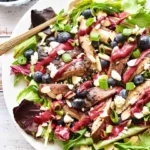Exploring the world of hibachi cooking at home can be an exciting adventure for your taste buds. This article will guide you through 16 delightful hibachi recipes that are simple and fun to make in your kitchen. From succulent meats to vibrant veggies, you’ll find a variety of options to suit your preferences.
What are the benefits of learning these recipes? Mastering hibachi cooking offers you the chance to enjoy restaurant-quality Japanese meals without leaving your house. Whether you’re cooking for family or hosting friends, these recipes can help you create memorable dining experiences right at home.

1) Shrimp Hibachi
Shrimp Hibachi is simply delicious and easy to make at home. Start by preheating a griddle to 400°F. Add two tablespoons of olive oil and heat it up. Next, add chopped zucchini and onion to the griddle. Saute these veggies for about three minutes, then add a teaspoon of minced garlic and cook for one more minute.
Set the veggies aside and melt one tablespoon of butter on the griddle. Place the raw shrimp in a single layer over the buttered area. Sprinkle with salt and pepper. Let the shrimp cook for one minute without moving them. Flip the shrimp, add one tablespoon of soy sauce, and let them cook for another minute.
Once the shrimp are cooked, you can combine the shrimp and veggies back on the griddle. Toss them together until everything is well mixed and evenly coated with the flavors. Serve your Shrimp Hibachi hot with a side of fried rice or noodles.
Making Shrimp Hibachi at home is quick and lets you bring those delightful Japanese steakhouse flavors right to your kitchen.

2) Chicken Hibachi with Vegetables
Chicken Hibachi with vegetables is a popular dish that you can easily make at home. Start by preheating your griddle or skillet to medium-high heat.
Add some vegetable oil and sesame oil to the hot surface. Toss in minced garlic and grated ginger, cooking until they’re fragrant.
Next, add bite-sized pieces of chicken to the griddle. Turn the chicken pieces frequently until they are light golden brown.
For the vegetables, you can use a mix of zucchini, mushrooms, onions, and bell peppers. Add them to the griddle with the chicken.
Season everything with soy sauce, salt, and pepper. Mix well and cook until the vegetables are just tender.
Serve your Chicken Hibachi with a side of fried rice or noodles for a complete meal.

3) Hibachi Steak and Scallops
You can create a delicious hibachi meal at home with steak and scallops. Start by heating a large pan over high heat. Add a bit of olive oil and let it get hot.
For the steak, cut it into bite-sized pieces. Season with salt and pepper. Cook the steak in the hot oil until it is browned on all sides, which should take about 3-4 minutes.
Meanwhile, prepare your scallops. Make sure they are dry before seasoning with a small pinch of salt and pepper. Place the seasoned side down in the hot pan.
Cook the scallops for about 1-2 minutes per side. They should have a nice golden color.
After cooking both, remove them from the pan. Add a bit of butter and garlic to the same pan and cook for about 30 seconds. Then, add soy sauce and let it simmer for a minute.
Combine the steak and scallops back into the pan with the sauce. Mix well to coat everything evenly. Serve your hibachi steak and scallops hot, along with your favorite side of vegetables or rice. It’s a simple yet impressive dish that will delight your taste buds.

4) Garlic Butter Hibachi Fried Rice
Garlic Butter Hibachi Fried Rice is a tasty and simple recipe you can make at home.
Start by heating a wok or large skillet over high heat. Add a spoonful of oil to the hot pan. Scramble an egg in the center and break it apart as it cooks. Move the egg to the side.
Add diced onions, minced garlic, and cubed carrots to the pan. Cook them for about 5 minutes until they are soft and fragrant. You can also add peas and scallions if you like.
Next, add cold, cooked rice to the pan. Stir the rice to mix it with the vegetables and eggs.
Add soy sauce and a bit of butter to the rice. Mix everything well until the rice is hot and flavorful. The garlic butter gives it a rich taste.
Serve your Garlic Butter Hibachi Fried Rice right away for the best flavor.
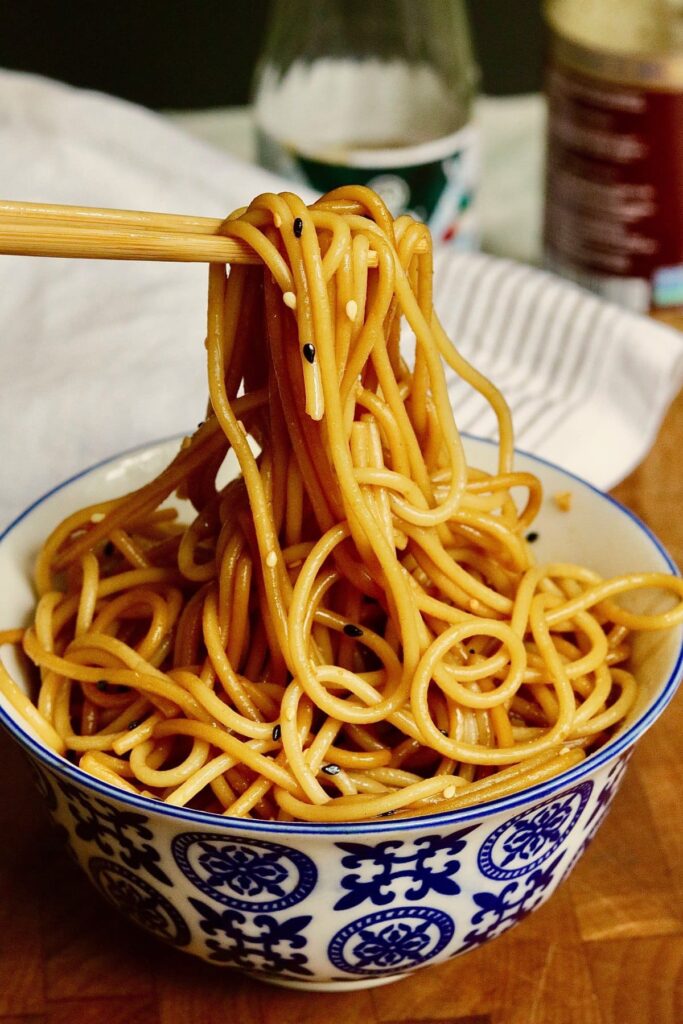
5) Hibachi Noodles with Mixed Vegetables
Hibachi noodles with mixed vegetables offer a tasty and healthy option. To start, cook your noodles in boiling water until they are al dente. Drain them well and set them aside.
Heat a large wok or frying pan over medium heat. Melt some butter and add minced garlic and ginger. Sauté until they are fragrant, about 2-3 minutes.
Next, add your choice of mixed vegetables. Common choices include onions, broccoli, bell peppers, and carrots. Stir-fry these until tender, usually taking about 4-5 minutes.
Add the cooked noodles to the vegetables. Pour in a mixture of soy sauce, teriyaki sauce, and a bit of mirin. Toss everything together so the noodles and vegetables are well-coated with the sauce.
Season with salt and pepper to taste. For an extra touch of flavor, you can drizzle a bit of sesame oil over the noodles before serving. Serve hot and enjoy your delightful hibachi noodles with mixed vegetables!
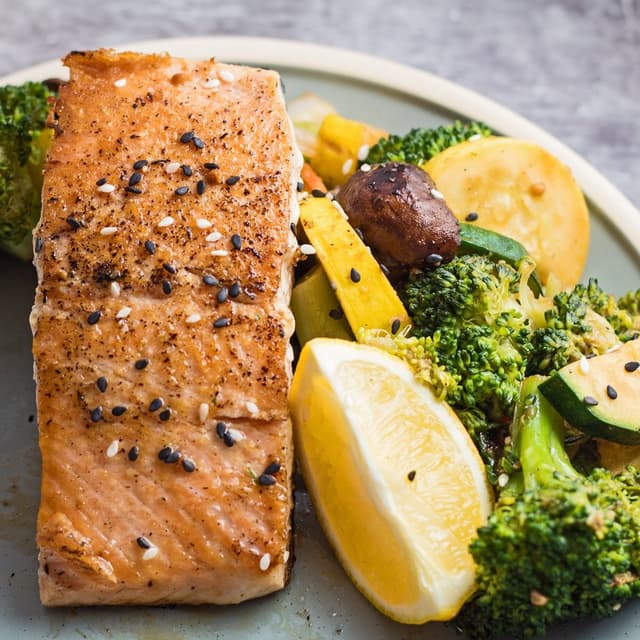
6) Spicy Hibachi Salmon
Spicy hibachi salmon is a delicious dish you can easily make at home. Start by preparing the salmon fillets. Pat them dry using a paper towel. This helps achieve a nice sear. Cut the salmon into 1-inch cubes for even cooking.
Heat a non-stick pan over medium-high heat. Add sesame oil and a bit of olive oil to the pan. Once the oil is hot and shimmering, add the salmon cubes in a single layer. Sear for about 4 minutes on one side, then flip and cook the other side for another 3-4 minutes until crispy.
While the salmon cooks, prepare a spicy sauce. Combine soy sauce, honey, fresh lemon juice, sesame oil, minced garlic, ginger, and a pinch of white pepper. To add spice, mix in some sriracha or red chili flakes. Stir well.
Once the salmon is done, pour the spicy sauce over the salmon cubes in the pan. Let it cook for an additional minute to coat the salmon evenly. This will give the fish a robust, spicy flavor. Serve your spicy hibachi salmon with steamed rice or sautéed vegetables for a complete meal.

7) Vegetarian Hibachi with Tofu
This dish is perfect if you are looking for a flavorful and nutritious vegetarian option. Start by pressing and cutting tofu into bite-sized cubes. This ensures it can soak up all the delicious flavors.
Heat some oil in a pan over medium-high heat. Use a mix of sesame and olive oil for the best taste. Add your tofu cubes to the pan and cook them until they are golden brown on all sides.
While the tofu is cooking, prepare the vegetables. Slice onions, carrots, and snow peas. These veggies add a crunchy texture to your meal. Add the onions to the pan first and cook until they are translucent.
Next, add carrots and snow peas. Stir-fry everything together for a few minutes. This helps to blend the flavors well. Pour in soy sauce and your favorite teriyaki sauce.
Finally, mix everything well and let it cook for another minute. This will thicken the sauce and coat all the tofu and veggies beautifully.
Enjoy your meal with a side of steamed rice or fried rice for a complete dish.

8) Hibachi Zucchini and Onions
Hibachi Zucchini and Onions is a simple and tasty side dish often served at Japanese steakhouses.
Start by cutting the zucchini into 2-inch long chunks. Then, cut each piece into six wedges. For the onion, trim the ends and cut them into 1 to 1.5-inch chunks.
Heat a large skillet or wok over medium-high heat. Add some vegetable oil and butter. Once hot, add the onions first and stir for about 5 minutes until they start to soften.
Next, add the zucchini pieces. Stir the vegetables every minute or so, cooking for about 4-5 more minutes. The zucchini should be tender but not mushy.
Optional sauces like soy sauce or teriyaki can enhance the flavor. A sprinkle of sesame seeds adds a nice touch. Enjoy your flavorful Hibachi Zucchini and Onions.

9) Scallop Hibachi with Lemon Butter
For a delicious scallop hibachi, start by melting butter in a large cast iron skillet over medium-high heat. Remove the small side muscle from the scallops, rinse them with cold water, and thoroughly pat them dry.
Lightly season the scallops with a pinch of salt and pepper. Add the scallops to the hot skillet in a single layer. Cook for about 1-2 minutes on each side until they are golden brown.
Next, prepare a simple lemon butter sauce. Melt some more butter and mix in grated garlic. Once combined, squeeze in fresh lemon juice and stir well.
Pour the lemon butter sauce over the cooked scallops. Let the sauce simmer for a minute to enhance the flavors. Serve the scallops immediately, and garnish with a sprinkle of fresh parsley or green onions if you like. These scallops pair well with steamed rice or stir-fried vegetables.

10) Hibachi Lobster Tail
Hibachi lobster tail is a delightful dish that can easily be prepared on a grill or griddle.
Begin by splitting the lobster tails in half. Brush them with a mix of olive oil and melted butter. This blend helps you cook at a higher temperature without burning the butter.
Season your lobster tails with salt and pepper. Place them split side down on the grill for 4-5 minutes. Then, flip them and cook for another 4-5 minutes, until the meat is opaque.
While the lobster cooks, prepare a simple butter sauce. In a small saucepan, melt some butter and mix in a touch of soy sauce. This will add a savory flavor to your lobster.
Once the lobster is cooked, drizzle the butter sauce over the lobster tails. Serve immediately, enjoying the rich, succulent flavors. This recipe brings the excitement of hibachi dining to your own home.
If you have a cheese melter, you can also cover the lobster tails while cooking to ensure even heating. This technique helps lock in moisture and flavor.

11) Teriyaki Hibachi Chicken
Teriyaki Hibachi Chicken combines the savory and sweet flavors of teriyaki sauce with the quick-cooking style of hibachi. To make this dish, you will need chicken breasts, soy sauce, sake, mirin, sugar, garlic, and ginger.
Start by preparing the teriyaki sauce. In a small bowl, whisk together soy sauce, sake, mirin, sugar, minced garlic, and minced ginger until well combined.
Season your chicken with salt and pepper. Brush the chicken with vegetable oil and preheat your grill to high heat. Grill the chicken for about 6-8 minutes on each side until fully cooked.
During the last few minutes of grilling, brush the chicken with the teriyaki sauce. This helps the chicken soak up the flavors and gives it a delicious glaze.
Once cooked, remove the chicken from the grill and let it rest for a few minutes before serving. This helps keep the chicken juicy and flavorful. Enjoy your teriyaki hibachi chicken with a side of fried rice or steamed vegetables!

12) Hibachi Pork Chops
Start by preheating your grill to medium heat, around 500°F. This temperature will help achieve a nice sear on the pork chops.
For the marinade, mix together soy sauce, vinegar, honey, oil, and pepper flakes. These ingredients combine to create a flavorful marinade that infuses the pork chops with a savory and slightly sweet taste.
Place the pork chops in a baking dish and pour half the marinade over them. Let the pork chops marinate for at least 10 minutes, or up to 2 hours. This allows the flavors to penetrate the meat.
Brush the grill grate with oil to prevent sticking. Place the marinated pork chops on the grill. Cook them for about 4-5 minutes on each side, depending on the thickness of the chops.
Use a meat thermometer to check if the pork chops have reached an internal temperature of 145°F. This ensures they are cooked through but still juicy.
Once cooked, remove the pork chops from the grill and let them rest for a few minutes. Use the reserved marinade as a sauce to drizzle over the chops.
Serve your hibachi pork chops with your favorite sides like grilled veggies or rice. Enjoy the delightful blend of flavors!
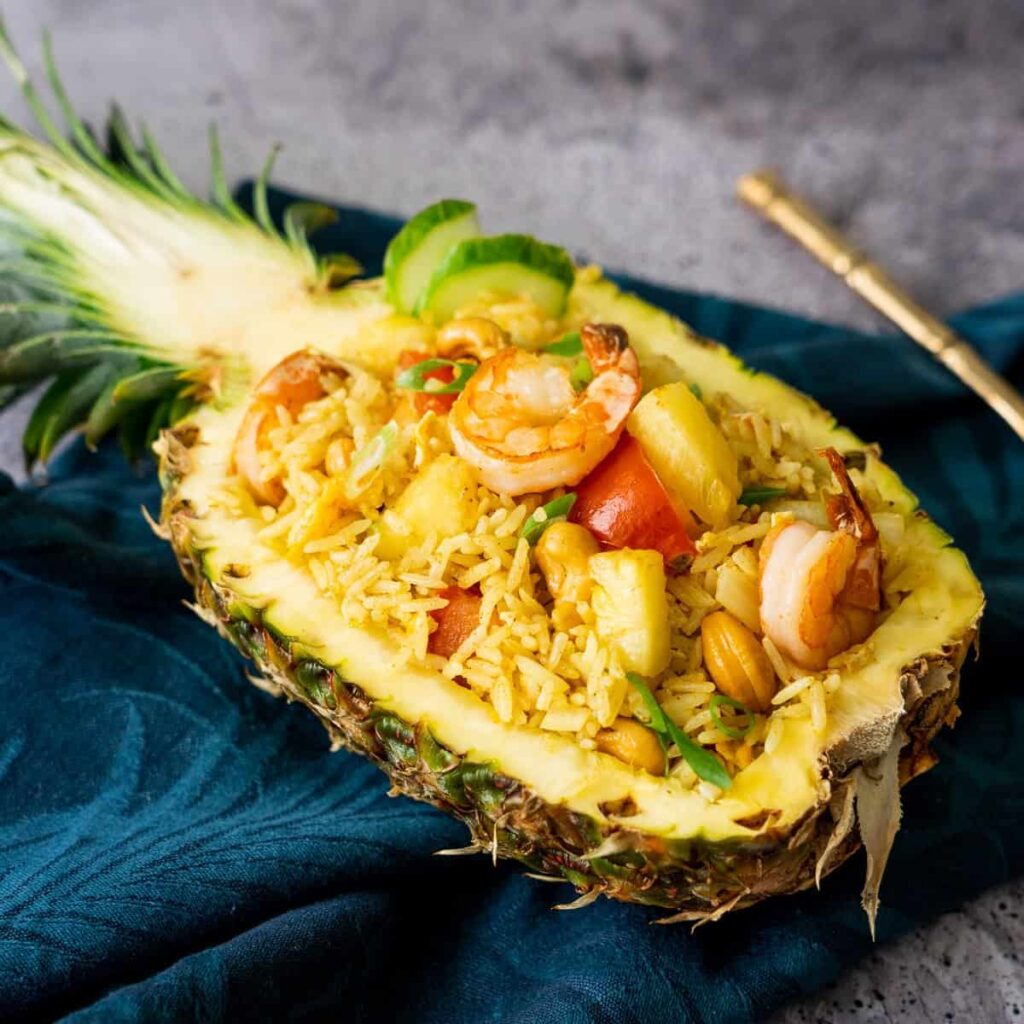
13) Hibachi Fried Rice with Pineapple
Hibachi fried rice with pineapple brings a sweet twist to the classic dish. Start by heating a wok or skillet on high.
Add a blend of hibachi cooking oil or use alternatives like canola or peanut oil.
Cook scrambled eggs in the heated oil. Break them apart and push them to the sides once done.
Next, sauté diced onions, minced garlic, green peas, and carrots for a couple of minutes. Move the veggies aside and fry the pineapple pieces until they caramelize slightly.
Mix the cooked veggies with the pineapple. Add day-old cooked rice to the pan and stir everything together. Cook for a few minutes until the rice is heated through.
Add soy sauce and a touch of sesame oil for extra flavor. Combine the scrambled eggs back into the mixture and stir well.
Finish with a handful of chopped green onions. Serve your hibachi fried rice with pineapple hot.
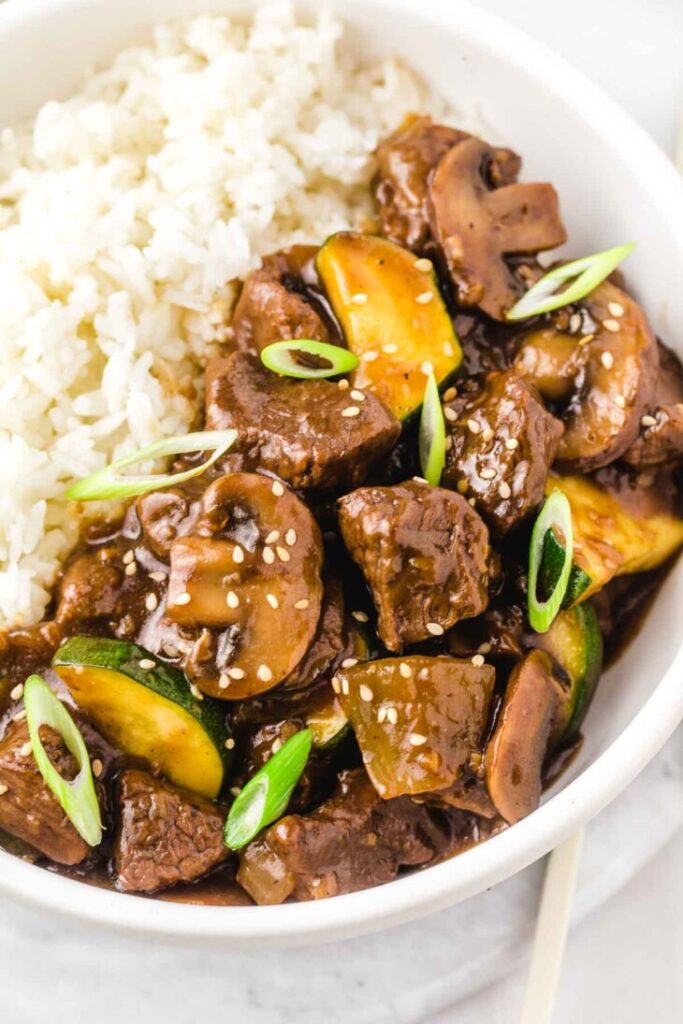
14) Beef Hibachi with Mushrooms
For this recipe, you’ll need thinly sliced beef, fresh mushrooms, garlic, soy sauce, and a bit of butter.
Start by heating a large pan over high heat and adding a small amount of olive oil.
Sear the beef slices for about 30 seconds on each side until browned.
Next, remove the beef and set it aside.
In the same pan, melt a bit of butter and add minced garlic.
Cook the garlic for 30 seconds until it becomes fragrant.
Then, add the sliced mushrooms and cook them until they are tender and browned, about 5 minutes.
Stir in soy sauce and let it mix with the mushrooms.
Return the beef to the pan and toss everything together.
Cook for another minute so the flavors blend well.
Serve your beef hibachi with mushrooms hot, and enjoy it with rice or noodles.

15) Hibachi Vegetable Delight
Hibachi Vegetable Delight is a tasty side dish that pairs well with many meals. You can use a variety of vegetables like zucchini, carrots, broccoli, mushrooms, and onions. These vegetables cook quickly and maintain a nice crunch.
Start by heating some oil and butter on a griddle or large skillet. When the oil is hot, add onions and cook until they are soft. Next, add garlic, zucchini, carrots, broccoli, and mushrooms.
For flavor, use soy sauce or a mix of soy and teriyaki sauce. Cook the vegetables for about 10 minutes, stirring often. You want them to be tender but not mushy.
Sesame seeds and green onions are good toppings. You can also add salt and pepper to taste. This dish is simple, but it’s full of flavor and texture.

16) Hibachi Chicken and Shrimp Combo
The Hibachi Chicken and Shrimp Combo is a delightful mix of flavors and textures. This dish brings together tender chicken and succulent shrimp, making it a crowd favorite.
Start by marinating your chicken in a mixture of soy sauce, minced garlic, and ginger for an hour or overnight. This helps infuse the meat with rich flavors.
In a large skillet, heat oil over medium-high heat. Add the chicken and cook until it is nearly done.
Next, add shrimp and continue to cook until both the chicken and shrimp are thoroughly cooked.
While the proteins cook, prepare your vegetables. Common choices include zucchini, onions, and mushrooms.
Cook the vegetables on the skillet until they are tender. Use soy sauce and a bit of butter to enhance the flavor.
Serve the Hibachi Chicken and Shrimp Combo with fried rice for a complete meal. The combination of savory meats and flavorful vegetables will impress anyone dining with you.
History of Hibachi Cooking
Hibachi cooking has roots in ancient Japan, evolving from a heating device to a popular cooking style. It showcases Japan’s culinary ingenuity and has spread worldwide due to its interactive dining experience.
Origins in Japanese Culture
The term hibachi translates to “fire bowl,” combining the words “hi” (fire) and “bachi” (bowl). Originally, hibachis were simple clay or metal containers filled with burning charcoal. Their primary use during the Heian period (794-1185) was for heating homes during the cold winter months.
Despite not initially being used for cooking, these portable heaters eventually evolved. People started to use these heated bowls for basic cooking tasks. This practicality laid the foundation for the hibachi style known today. This period marked the beginning of hibachi’s dual role in Japanese households as both a heating device and a cooking method.
Evolution and Global Influence
Over time, hibachi cooking evolved. By the 20th century, the method became popular in restaurants. Chefs began using flat-top grills, which differed from the traditional bowl-shaped hibachi. These grills allowed for a more interactive cooking experience, with chefs preparing and cooking meals directly in front of diners.
This style of cooking captivated audiences due to its combination of skill, entertainment, and delicious food. As hibachi restaurants spread globally, the cooking style adapted to local tastes. Chefs incorporated elements from other cuisines, making hibachi a worldwide phenomenon. Now, you can enjoy hibachi-style cooking not just in Japan, but in numerous countries, offering a unique dining experience that blends tradition with modern culinary innovation.
Essential Ingredients for Hibachi Recipes
In hibachi cooking, the right combination of proteins, vegetables, sauces, and seasonings creates a unique flavor. Here, you’ll find the most important ingredients you’ll need.
Key Proteins and Vegetables
Proteins: You can choose from a variety of proteins such as chicken, beef, shrimp, and fish. Chicken and shrimp are particularly popular. Chicken breasts, peeled shrimp, and steak (like ribeye) are all great options. These proteins cook quickly and absorb flavors well.
Vegetables: Common vegetables include zucchini, onions, mushrooms, carrots, and broccoli. Zucchini and onions are often sautéed together, while mushrooms add a rich, earthy flavor. Slice the veggies evenly for consistent cooking. Carrots and broccoli add color and texture to the dish.
Popular Sauces and Seasonings
Soy Sauce: Soy sauce is a basic ingredient that adds umami flavor. Light and dark soy sauces can be used to adjust the taste.
Garlic: Fresh garlic or garlic powder enhances the dish’s savory profile. Sauté minced garlic with the vegetables or proteins to infuse your meal with a robust flavor.
Butter: Butter adds richness and helps in browning the proteins and vegetables. Melted butter mixed with soy sauce creates a delicious glaze.
Sesame Oil: A small amount of sesame oil imparts a nutty aroma. Use it for stir-frying or as a finishing touch.
Other Condiments: Additional seasonings like salt, black pepper, and sometimes sugar balance the flavors. Soy sauce, mirin, and sake are common ingredients in marinades.
Tips for Cooking Hibachi at Home
Cooking hibachi at home can be a fun and delicious experience. To get the best results, you need the right equipment and knowledge on how to sear your ingredients perfectly.
Choosing the Right Equipment
When cooking hibachi at home, having the right tools is essential. A griddle or flat-top grill is ideal for hibachi. It provides even heat distribution, allowing you to cook your ingredients consistently.
You might also use a large cast-iron skillet or a wok if you don’t have a griddle. Make sure your pan is heavy-duty to handle high temperatures.
Using long-handled spatulas and tongs helps you safely manage the food without getting too close to the heat. These tools are particularly useful for flipping and stirring ingredients quickly.
Finally, make sure you have a sharp knife for cutting meat and vegetables. Precision is key in hibachi cooking, so you want your cuts to be uniform to ensure even cooking.
Techniques for Perfect Searing
Searing your ingredients properly is crucial for that authentic hibachi flavor. Start by preheating your griddle or pan to a high temperature, about 350°F.
Use vegetable oil or another oil with a high smoke point. Spread the oil thinly across the cooking surface to create a non-stick layer.
Cook in small batches to avoid overcrowding. Overcrowding lowers the pan’s temperature, which prevents proper searing and can make the food steam instead.
For vegetables like zucchini, onions, and mushrooms, allow them to brown without moving for a few minutes. After they start to brown, stir and cook for an additional few minutes until tender.
For meats, sear each side until you get a nice browned crust. Use high heat for a short time and then lower the heat to continue cooking without burning. Once seared, cut the meat into bite-sized pieces to ensure they cook thoroughly and evenly.
By following these techniques, you’ll achieve the same seared textures and flavors found in professional hibachi restaurants.





